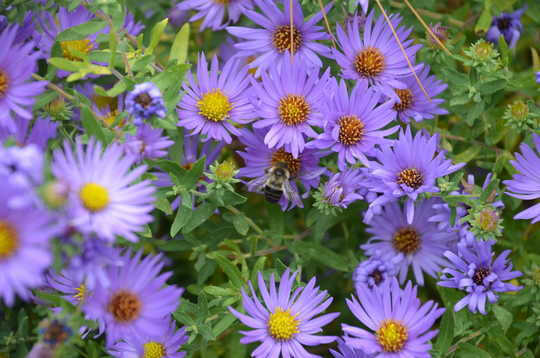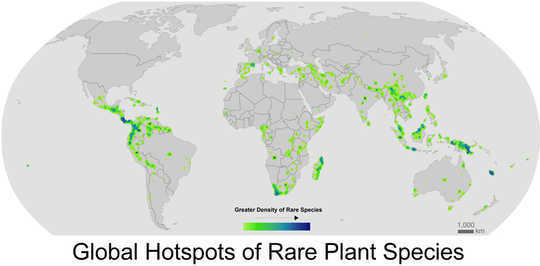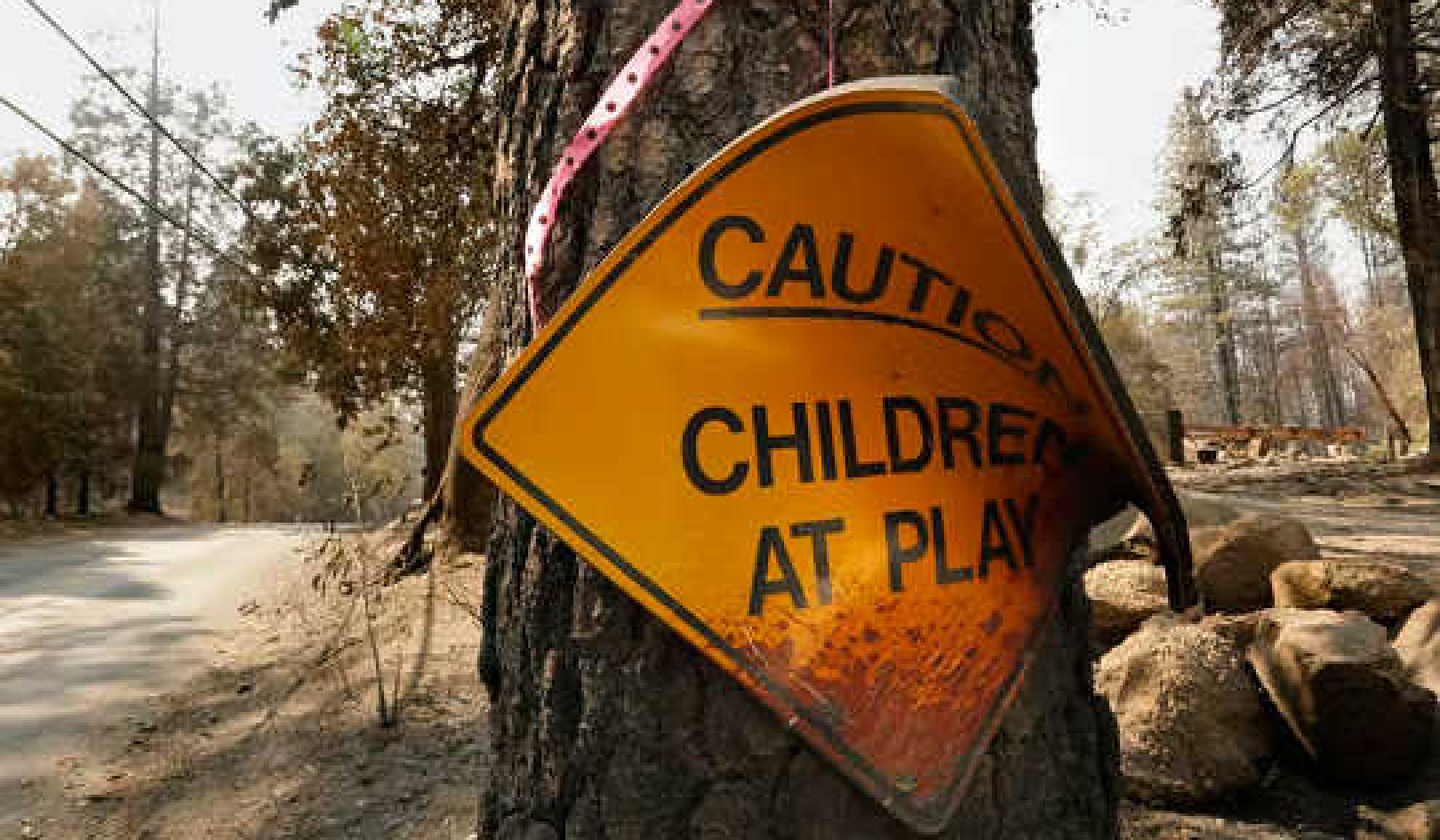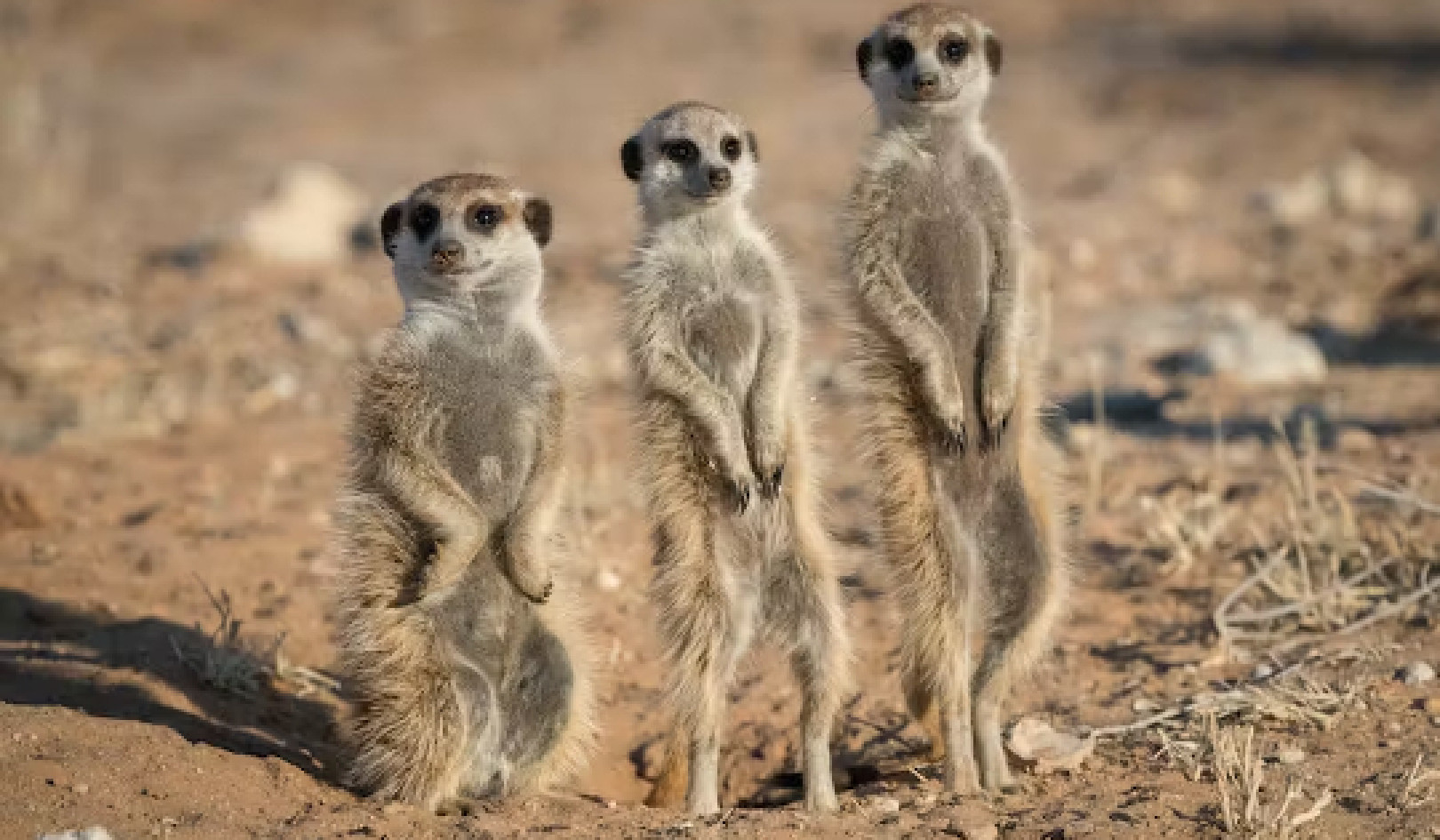
Almost 40% of global land plant species are very rare, and these species are most at risk for extinction as the climate continues to change, according to new research.
“When talking about global biodiversity, we had a good approximation of the total number of land plant species, but we didn’t have a real handle on how many there really are,” says lead author Brian Enquist, University of Arizona professor of ecology and evolutionary biology.
Researchers worked for 10 years to compile 20 million observational records of the world’s land plants. The result is the largest dataset on botanical biodiversity ever created. The researchers hope this information can help reduce loss of global biodiversity by informing strategic conservation action that includes consideration of the effects of climate change.
They found that there are about 435,000 unique land plant species on Earth.
 A map of rare species hot spots around the globe. (Credit: Patrick R. Roehrdanz)
A map of rare species hot spots around the globe. (Credit: Patrick R. Roehrdanz)
“That’s an important number to have, but it’s also just bookkeeping. What we really wanted to understand is the nature of that diversity and what will happen to this diversity in the future,” Enquist says. “Some species are found everywhere—they’re like the Starbucks of plant species. But others are very rare—think a small standalone café.”
Enquist and his team revealed that 36.5% of all land plant species are “exceedingly rare,” meaning they have been observed and recorded less than five times ever.
“According to ecological and evolutionary theory, we’d expect many species to be rare, but the actual observed number we found was actually pretty startling,” he says. “There are many more rare species than we expected.”
The researchers also found that rare species tend to cluster in a handful of hot spots, such as the Northern Andes in South America, Costa Rica, South Africa, Madagascar, and Southeast Asia. These regions, they found, remained climatologically stable as the world emerged from the last ice age, allowing such rare species to persist.
But just because these species enjoyed a relatively stable climate in the past doesn’t mean they’ll enjoy a stable future. The study also shows that these hot spots of very rare species are projected to experience a disproportionally high rate of future climatic changes and human disruption, Enquist says.
“We learned that in many of these regions, there’s increasing human activity such as agriculture, cities and towns, land use and clearing. So that’s not exactly the best of news,” he says. “If nothing is done, this all indicates that there will be a significant reduction in diversity—mainly in rare species—because their low numbers make them more prone to extinction.”
And it’s these rare species that science knows very little about.
By mapping where these rare species occur, “this work is better able to highlight the dual threats of climate change and human impact on the regions that harbor much of the world’s rare plant species and emphasizes the need for strategic conservation to protect these cradles of biodiversity,” says Patrick Roehrdanz a coauthor on the paper and managing scientist at Conservation International.
The findings appear in Science Advances.
Support for the research came from Conservation International and the National Science Foundation. The Spatial Planning for Area Conservation in Response to Climate Change project, which the Global Environment Facility funded, also contributed to the research.
About the Authors
Study's lead author: Brian Enquist, University of Arizona professor of ecology and evolutionary biology. Patrick Roehrdanz is a coauthor on the paper and managing scientist at Conservation International.
Related Books
Life After Carbon: The Next Global Transformation of Cities
by Peter Plastrik , John Cleveland The future of our cities is not what it used to be. The modern-city model that took hold globally in the twentieth century has outlived its usefulness. It cannot solve the problems it helped to create—especially global warming. Fortunately, a new model for urban development is emerging in cities to aggressively tackle the realities of climate change. It transforms the way cities design and use physical space, generate economic wealth, consume and dispose of resources, exploit and sustain the natural ecosystems, and prepare for the future. Available On Amazon
The future of our cities is not what it used to be. The modern-city model that took hold globally in the twentieth century has outlived its usefulness. It cannot solve the problems it helped to create—especially global warming. Fortunately, a new model for urban development is emerging in cities to aggressively tackle the realities of climate change. It transforms the way cities design and use physical space, generate economic wealth, consume and dispose of resources, exploit and sustain the natural ecosystems, and prepare for the future. Available On Amazon
The Sixth Extinction: An Unnatural History
by Elizabeth Kolbert Over the last half-billion years, there have been Five mass extinctions, when the diversity of life on earth suddenly and dramatically contracted. Scientists around the world are currently monitoring the sixth extinction, predicted to be the most devastating extinction event since the asteroid impact that wiped out the dinosaurs. This time around, the cataclysm is us. In prose that is at once frank, entertaining, and deeply informed, New Yorker writer Elizabeth Kolbert tells us why and how human beings have altered life on the planet in a way no species has before. Interweaving research in half a dozen disciplines, descriptions of the fascinating species that have already been lost, and the history of extinction as a concept, Kolbert provides a moving and comprehensive account of the disappearances occurring before our very eyes. She shows that the sixth extinction is likely to be mankind's most lasting legacy, compelling us to rethink the fundamental question of what it means to be human. Available On Amazon
Over the last half-billion years, there have been Five mass extinctions, when the diversity of life on earth suddenly and dramatically contracted. Scientists around the world are currently monitoring the sixth extinction, predicted to be the most devastating extinction event since the asteroid impact that wiped out the dinosaurs. This time around, the cataclysm is us. In prose that is at once frank, entertaining, and deeply informed, New Yorker writer Elizabeth Kolbert tells us why and how human beings have altered life on the planet in a way no species has before. Interweaving research in half a dozen disciplines, descriptions of the fascinating species that have already been lost, and the history of extinction as a concept, Kolbert provides a moving and comprehensive account of the disappearances occurring before our very eyes. She shows that the sixth extinction is likely to be mankind's most lasting legacy, compelling us to rethink the fundamental question of what it means to be human. Available On Amazon
Climate Wars: The Fight for Survival as the World Overheats
by Gwynne Dyer Waves of climate refugees. Dozens of failed states. All-out war. From one of the world’s great geopolitical analysts comes a terrifying glimpse of the strategic realities of the near future, when climate change drives the world’s powers towards the cut-throat politics of survival. Prescient and unflinching, Climate Wars will be one of the most important books of the coming years. Read it and find out what we’re heading for. Available On Amazon
Waves of climate refugees. Dozens of failed states. All-out war. From one of the world’s great geopolitical analysts comes a terrifying glimpse of the strategic realities of the near future, when climate change drives the world’s powers towards the cut-throat politics of survival. Prescient and unflinching, Climate Wars will be one of the most important books of the coming years. Read it and find out what we’re heading for. Available On Amazon
From The Publisher:
Purchases on Amazon go to defray the cost of bringing you InnerSelf.comelf.com, MightyNatural.com, and ClimateImpactNews.com at no cost and without advertisers that track your browsing habits. Even if you click on a link but don't buy these selected products, anything else you buy in that same visit on Amazon pays us a small commission. There is no additional cost to you, so please contribute to the effort. You can also use this link to use to Amazon at any time so you can help support our efforts.






















